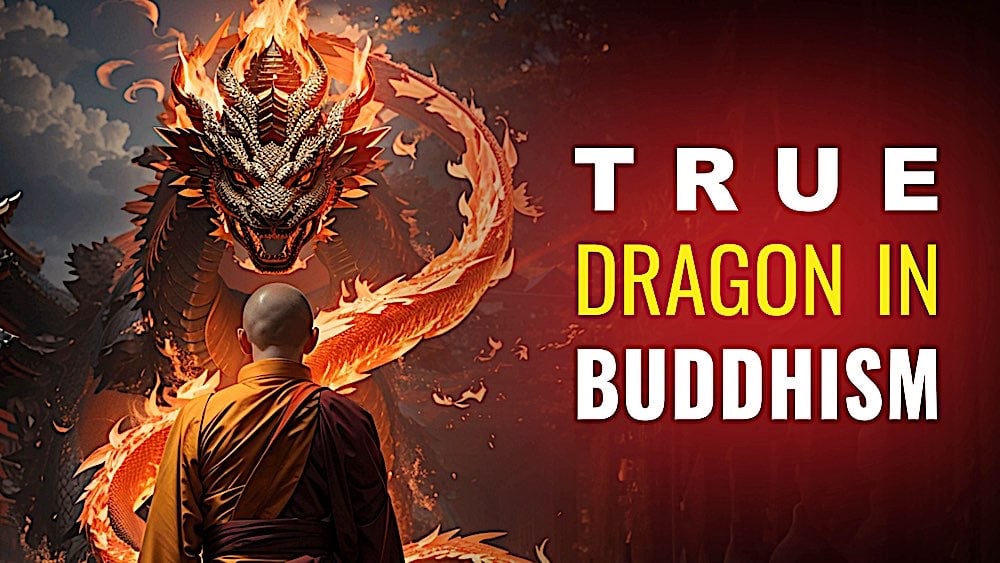Dragons in Buddhism: The Zen Tale of the True Dragon; Guanyin and the Dragon King’s son
What would you do, if one morning you woke up to find a real dragon coiled by your bed, its scales and teeth glittering in the moonlight? Would you scream in terror, or embrace the opportunity to learn? In...

What would you do, if one morning you woke up to find a real dragon coiled by your bed, its scales and teeth glittering in the moonlight? Would you scream in terror, or embrace the opportunity to learn? In this feature, we explore why Dragons remain important in most traditions of Buddhism, and why they are associated with Shakyamuni Buddha, Amitabha, Avalokiteshvara Guan Yin and Tara. Come along with us now, into the very real world of Buddhist dragons!
From our YoutubeChannel>>
In Zen or Chan Buddhism, the Tale of the True Dragon is used by teachers to illustrate the importance of true practice over entirely intellectual study.
In the Buddhist zen story of the True Dragon, a “real” dragon decides to visit one of his Buddhist admirers:
“There was a monk who loved dragons. He studied dragon lore and decorated his room with paintings and statues of dragons. He would talk on and on about dragons to anyone who would listen. One day a dragon heard about him and thought, how lovely that this man appreciates us. It would surely make him happy to meet a true dragon. The kindly dragon flew to the monk’s room and went inside, to find him asleep.
The monk woke up and saw the dragon coiled by his bed, its scales and teeth glittering in the moonlight. Before the dragon could introduce himself, the monk screamed in terror, terrified of that which he thought he loved and understood. The dragon flew away, never to return.”
This story is meant to illustrate how it is important to have a teacher, take refuge and — more importantly — to practice, not simply to hang up pictures and study sutra. In the story the monk told everyone he loved dragons, put up pictures, and said he was an expert.
Then, when the True Dragon appeared, he didn’t understand. He panicked and scared off the friendly dragon. He didn’t understand that Buddhism is meant to be practiced, rather than reduced to form, theory and intellectual comprehension.
It is more important to meet the Dharma through practice, than to philosophize and tell stories. So, if a dragon ever appears in your bedroom, remember to say Hi. Don’t scream and run away.
Why was a Buddhist monk obsessed with dragons? In Buddhism, dragons are important symbols and appear everywhere. They are associated with Amitabha, Guanyin or Avalokiteshvara, and the entire Lotus family.
Dragons are forces of nature in Buddhism. They actually appear in Mahayana Sutra — for example when Shakyamuni Buddha taught the dragon king. There are many charming stories of Guan Yin Avalokiteshvara and dragons, most with lessons in compassion, most notable the story of Longnu and Sudhana (a.k.a. Dragon Girl and Shan Tsai) who appear in the Lotus Sutra in Chapter 12.
“Many years after Shan Tsai became a disciple of Guan Yin, a distressing event happened in the South Sea. The son of the Dragon King was caught by a fisherman while taking the form of a fish. Being stuck on land, he was unable to transform back into his dragon form. His father, despite being a mighty Dragon King, was unable to do anything while his son was on land. Distressed, the son called out to all of Heaven and Earth.
Hearing this cry, Guan Yin quickly sent Shan Tsai to recover the fish. Shan Tsai begged the fish seller to spare the life of the fish.
The crowd, now angry at someone so daring, was about to chase him away from the fish when Guan Yin projected her voice from far away, saying “A life should definitely belong to one who tries to save it, not one who tries to take it.”
The crowd realizing their shameful actions and desire, dispersed. Shan Tsai brought the fish back to Guan Yin, who promptly returned it to the sea. There the fish transformed back to a dragon and returned home.
As a reward for Guan Yin’s help saving his son, the Dragon King sent his daughter, a girl called Lung Nue (“dragon girl”), to present to Guan Yin the ‘Pearl of Light’. The ‘Pearl of Light’ was a precious jewel owned by the Dragon King that constantly shone. Lung Nue, overwhelmed by the presence of Guan Yin, asked to be her disciple so that she might study the Buddha Dharma.

 Astrong
Astrong 
































